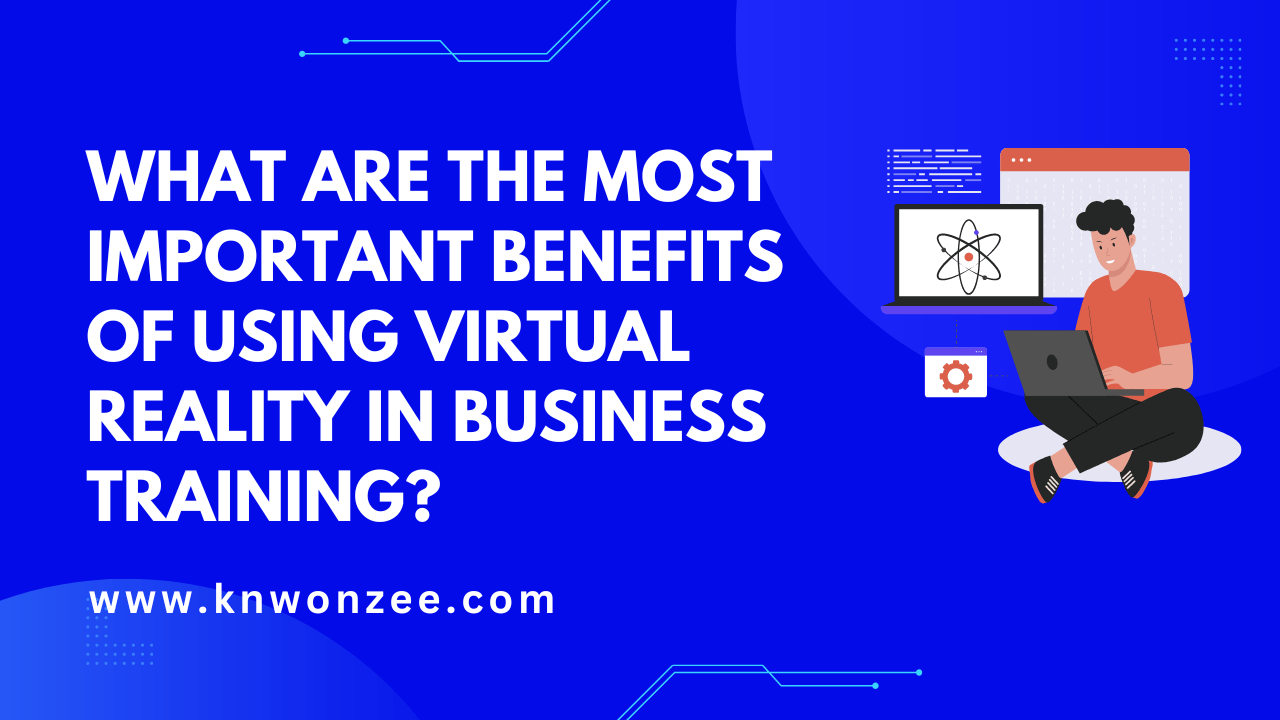What are the Most Important Benefits of Using Virtual Reality in Business Training?

In a fast-evolving corporate landscape, staying ahead of the curve is crucial for business success. One of the most transformative tools making waves in professional development is virtual reality (VR). This revolutionary technology isn’t just for gamers; it’s redefining the way companies train their employees. From enhanced engagement to cost-effective solutions, the benefits of using virtual reality in business training are nothing short of astounding.
Prepare to be captivated by our in-depth analysis of ‘What are the Most Important Benefits of Using Virtual Reality in Business Training?’. Whether you’re a novice or an expert, this article is designed to inform and inspire, providing you with a fresh perspective on this intriguing subject. Get ready to be enlightened!
Unleashing Engagement Beyond Boundaries
Traditional training methods often struggle to capture employees’ attention. However, virtual reality is a game-changer. The immersive nature of VR transports participants into simulated scenarios, enabling them to experience real-world situations firsthand. This heightened sense of presence ensures that trainees remain engaged and invested in the learning process.
Through interactive VR solutions, employees can explore complex concepts in a visually appealing and interactive manner. This hands-on approach not only fosters better understanding but also leads to longer-lasting knowledge retention. The ability to actively participate in training scenarios creates a sense of agency that empowers individuals to take ownership of their learning journey.
Creating Realistic Learning Environments
Imagine training for high-pressure scenarios without any real-world consequences. VR simulations enable businesses to create hyper-realistic training environments that mimic the challenges employees might encounter. From customer interactions to emergency drills, employees can practice their skills in a safe space, eliminating the fear of making mistakes that could have real-world repercussions.
For instance, medical professionals can perform intricate surgeries without putting patients at risk, while customer service representatives can navigate tricky client interactions without compromising customer relationships. This seamless blend of experiential learning and risk-free practice is a game-changer for skill enhancement.
Elevating Skill Development and Performance
One of the most significant advantages of VR in corporate training lies in its ability to facilitate hands-on skill development. Employees can hone their skills in a controlled and repetitive manner, leading to mastery over time. Whether it’s refining negotiation techniques or perfecting manufacturing processes, the immersive nature of VR allows for focused skill-building.
Moreover, VR-based training caters to diverse learning styles. Some employees learn best through visual experiences, while others thrive in interactive environments. VR training accommodates both preferences, ensuring that every employee can access training in a way that resonates with them.
Cost-Effective Training Solutions
Traditional training methods often involve substantial costs, from hiring trainers to arranging physical materials. Virtual reality offers a cost-effective alternative that reduces the need for elaborate setups. With VR headsets becoming more accessible, businesses can implement immersive training without breaking the bank.
Additionally, VR training eliminates the need for physical space, travel expenses, and printed materials. This not only reduces the financial burden but also contributes to a more environmentally sustainable approach to training.
Boosting Employee Confidence and Morale
When employees feel confident in their skills, their overall morale and job satisfaction improve. VR training directly impacts confidence levels by allowing employees to practice and refine their skills in a risk-free environment. As they witness their progress and growth, their self-assurance soars.
Confident employees are more likely to take on new challenges, contribute innovative ideas, and engage more effectively with colleagues and clients. This positive attitude ripples throughout the organization, fostering a culture of continuous improvement and adaptability.
Measurable Outcomes and Data-Driven Insights
Businesses thrive on data, and VR training provides a goldmine of information. Through VR simulations, companies can track trainees’ performance, identify areas for improvement, and tailor training modules accordingly. This data-driven approach ensures that training programs remain dynamic and effective.
Quantifiable metrics, such as completion rates, accuracy levels, and reaction times, offer valuable insights into the effectiveness of VR training. Businesses can make informed decisions about refining content and addressing specific pain points, resulting in a more streamlined and impactful training process.
Realizing the Future of Corporate Training
As technology continues to evolve, the future of corporate training lies in the hands of virtual reality. VR technology is not only reshaping how training is delivered but also how it’s perceived. Employees are more likely to embrace training that leverages cutting-edge tools, showcasing a commitment to their growth and development.
From large corporations to small startups, the advantages of incorporating VR in training are undeniable. Businesses that embrace this transformative technology position themselves as pioneers in the realm of professional development, attracting top talent and ensuring long-term success.
Driving Collaboration and Teamwork
In today’s interconnected business landscape, collaboration and teamwork are essential for achieving goals and solving complex challenges. Virtual reality takes teamwork to new heights by allowing employees to collaborate in shared virtual spaces regardless of their physical locations. This is especially valuable for companies with remote teams or global offices.
Through VR platforms, team members can gather in virtual meeting rooms, brainstorm ideas on interactive virtual whiteboards, and work together on projects in real-time. This immersive collaboration transcends geographical barriers, fostering a sense of unity and camaraderie among team members. As a result, employees feel more connected and motivated to work towards common objectives, even if they’re miles apart.
Personalized Learning Pathways
Every employee has unique learning needs and career aspirations. Virtual reality enables businesses to create personalized learning experiences that cater to individual preferences and goals. With VR’s adaptability, training modules can be customized to address specific skill gaps or developmental requirements.
Through data analysis and AI-driven insights, businesses can identify each employee’s strengths and areas for improvement. Virtual reality then allows for the creation of tailored training scenarios that challenge employees at the appropriate level and pace. This personalized approach not only accelerates skill development but also boosts employees’ sense of value within the organization.
Enhancing Onboarding and Upskilling
Onboarding new employees can be a time-consuming process, especially when it involves extensive orientation and training sessions. Virtual reality streamlines the onboarding process by providing immersive experiences that introduce new hires to the company’s culture, values, and operational procedures.
Beyond onboarding, VR also facilitates continuous upskilling. As industries evolve, employees need to acquire new skills to remain relevant. VR training allows for seamless integration of updated content, ensuring that employees stay up-to-date with the latest industry trends and advancements.
Reducing Training Time and Time-to-Competence
Traditional training methods often require extended periods of time before employees reach a level of competence. Virtual reality accelerates this timeline by providing intensive and focused training experiences. Through realistic simulations and repetitive practice, employees can develop proficiency more rapidly.
For instance, flight simulators have been used for decades to train pilots effectively and efficiently. Similarly, VR training shortens the learning curve across various industries, from manufacturing and healthcare to customer service and sales. This reduction in training time translates to faster time-to-competence for employees, allowing them to contribute to their roles sooner and more effectively.
Supporting Soft Skills Development
While technical skills are crucial, soft skills such as communication, empathy, and leadership are equally vital in today’s business environment. Virtual reality uniquely addresses the challenge of developing these skills by placing employees in emotionally charged scenarios that require thoughtful and empathetic responses.
Through VR simulations, employees can practice handling difficult conversations, delivering impactful presentations, and navigating interpersonal dynamics. These experiential learning opportunities nurture emotional intelligence and self-awareness, qualities that contribute to effective leadership and cohesive teamwork.
Frequently Asked Questions
1. Can virtual reality replace traditional training methods entirely?
While virtual reality offers numerous advantages, it’s not always a one-size-fits-all solution. It excels in immersive and experiential training but might not replace all aspects of traditional training. A blended approach, combining the strengths of both methods, can provide a comprehensive and effective training program.
2. How can small businesses afford virtual reality training solutions?
The cost of VR technology has been steadily decreasing, making it more accessible to businesses of all sizes. Additionally, there are VR platforms and applications that cater to specific industries and skill sets, offering cost-effective solutions without compromising quality.
3. Are there any studies proving the effectiveness of VR training?
Yes, numerous studies have demonstrated the effectiveness of VR training in enhancing learning outcomes, knowledge retention, and skill development. Academic institutions and corporate research have consistently shown the positive impact of immersive learning experiences.
4. Is virtual reality training suitable for all industries?
Virtual reality training is versatile and can be adapted to various industries, from healthcare and manufacturing to retail and hospitality. Its success depends on the specific training objectives and the creative implementation of relevant scenarios.
5. How can companies measure the ROI of VR training?
Measuring the ROI of VR training involves analyzing various factors, including improved employee performance, reduced training time, decreased error rates, and increased customer satisfaction. Tracking these metrics and comparing them to the costs of implementing VR technology provides valuable insights into ROI.
6. Can VR training be integrated with existing learning management systems?
Yes, many VR training platforms offer integration with existing learning management systems (LMS). This allows businesses to seamlessly incorporate VR modules into their existing training infrastructure, ensuring a cohesive learning experience for employees.
7. What is the future of VR in business training?
The future of VR in business training is promising. As technology continues to advance, VR experiences will become even more immersive, realistic, and interactive. Additionally, the integration of AI and data analytics will further personalize and enhance training outcomes.
Also Read: What is an Example of Using Quantum Computing for Sustainable Practices?
Conclusion
Virtual reality is more than just a buzzword; it’s a transformative tool that is reshaping the landscape of business training. From enhancing engagement and collaboration to enabling personalized learning pathways and fostering soft skills, the benefits of using virtual reality are vast and impactful. As businesses strive to remain competitive and agile, embracing VR in training is a strategic move towards creating a skilled, confident, and innovative workforce poised for success in the ever-evolving corporate world.
To sum it up, this article has shed light on various aspects of “What are the Most Important Benefits of Using Virtual Reality in Business Training?,” providing valuable insights and answering your most pressing questions.






